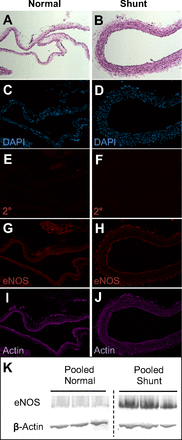Altered reactivity and nitric oxide signaling in the isolated thoracic duct from an ovine model of congenital heart disease with increased pulmonary blood flow
- PMID: 24531811
- PMCID: PMC4116402
- DOI: 10.1152/ajpheart.00841.2013
Altered reactivity and nitric oxide signaling in the isolated thoracic duct from an ovine model of congenital heart disease with increased pulmonary blood flow
Abstract
We have previously shown decreased pulmonary lymph flow in our lamb model of chronically increased pulmonary blood flow, created by the in utero placement of an 8-mm aortopulmonary shunt. The purpose of this study was to test the hypothesis that abnormal lymphatic function in shunt lambs is due to impaired lymphatic endothelial nitric oxide (NO)-cGMP signaling resulting in increased lymphatic vascular constriction and/or impaired relaxation. Thoracic duct rings were isolated from 4-wk-old shunt (n = 7) and normal (n = 7) lambs to determine length-tension properties, vascular reactivity, and endothelial NO synthase protein. At baseline, shunt thoracic duct rings had 2.6-fold higher peak to peak tension and a 2-fold increase in the strength of contractions compared with normal rings (P < 0.05). In response to norepinephrine, shunt thoracic duct rings had a 2.4-fold increase in vascular tone compared with normal rings (P < 0.05) and impaired relaxation in response to the endothelium-dependent dilator acetylcholine (63% vs. 13%, P < 0.05). In vivo, inhaled NO (40 ppm) increased pulmonary lymph flow (normalized for resistance) ∼1.5-fold in both normal and shunt lambs (P < 0.05). Inhaled NO exposure increased bioavailable NO [nitrite/nitrate (NOx); ∼2.5-fold in normal lambs and ∼3.4-fold in shunt lambs] and cGMP (∼2.5-fold in both) in the pulmonary lymph effluent (P < 0.05). Chronic exposure to increased pulmonary blood flow is associated with pulmonary lymphatic endothelial injury that disrupts NO-cGMP signaling, leading to increased resting vasoconstriction, increased maximal strength of contraction, and impaired endothelium-dependent relaxation. Inhaled NO increases pulmonary lymph NOx and cGMP levels and pulmonary lymph flow in normal and shunt lambs. Therapies that augment NO-cGMP signaling within the lymphatic system may provide benefits, warranting further study.
Keywords: lymphatic endothelial function; nitric oxide; nitric oxide-cGMP signaling.
Figures






Similar articles
-
Disrupted NOS signaling in lymphatic endothelial cells exposed to chronically increased pulmonary lymph flow.Am J Physiol Heart Circ Physiol. 2016 Jul 1;311(1):H137-45. doi: 10.1152/ajpheart.00649.2015. Epub 2016 May 13. Am J Physiol Heart Circ Physiol. 2016. PMID: 27199125 Free PMC article.
-
Blunted flow-mediated responses and diminished nitric oxide synthase expression in lymphatic thoracic ducts of a rat model of metabolic syndrome.Am J Physiol Heart Circ Physiol. 2016 Feb 1;310(3):H385-93. doi: 10.1152/ajpheart.00664.2015. Epub 2015 Dec 4. Am J Physiol Heart Circ Physiol. 2016. PMID: 26637560 Free PMC article.
-
Alterations in endogenous nitric oxide production after cardiopulmonary bypass in lambs with normal and increased pulmonary blood flow.Circulation. 2000 Nov 7;102(19 Suppl 3):III172-8. doi: 10.1161/01.cir.102.suppl_3.iii-172. Circulation. 2000. PMID: 11082382
-
Physiological Roles of Lymph Flow-Mediated Nitric Oxide in Lymphatic System.Lymphat Res Biol. 2023 Jun;21(3):253-261. doi: 10.1089/lrb.2022.0072. Epub 2022 Dec 26. Lymphat Res Biol. 2023. PMID: 36577034 Review.
-
Lymphatic interventions in congenital heart disease.Semin Pediatr Surg. 2024 Jun;33(3):151419. doi: 10.1016/j.sempedsurg.2024.151419. Epub 2024 May 23. Semin Pediatr Surg. 2024. PMID: 38830312 Review.
Cited by
-
Respiratory mechanics and gas exchange in an ovine model of congenital heart disease with increased pulmonary blood flow and pressure.Front Physiol. 2023 Jun 9;14:1188824. doi: 10.3389/fphys.2023.1188824. eCollection 2023. Front Physiol. 2023. PMID: 37362431 Free PMC article.
-
Lymphatic remodelling in response to lymphatic injury in the hind limbs of sheep.Nat Biomed Eng. 2020 Jun;4(6):649-661. doi: 10.1038/s41551-019-0493-1. Epub 2019 Dec 23. Nat Biomed Eng. 2020. PMID: 31873209 Free PMC article.
-
Lymphatic dysfunction in critical illness.Curr Opin Pediatr. 2018 Jun;30(3):332-337. doi: 10.1097/MOP.0000000000000623. Curr Opin Pediatr. 2018. PMID: 29538048 Free PMC article. Review.
-
Disrupted NOS signaling in lymphatic endothelial cells exposed to chronically increased pulmonary lymph flow.Am J Physiol Heart Circ Physiol. 2016 Jul 1;311(1):H137-45. doi: 10.1152/ajpheart.00649.2015. Epub 2016 May 13. Am J Physiol Heart Circ Physiol. 2016. PMID: 27199125 Free PMC article.
-
Biomaterials for Modulating Lymphatic Function in Immunoengineering.ACS Pharmacol Transl Sci. 2019 Sep 4;2(5):293-310. doi: 10.1021/acsptsci.9b00047. eCollection 2019 Oct 11. ACS Pharmacol Transl Sci. 2019. PMID: 32259064 Free PMC article. Review.
References
-
- Black S, Fineman J, Johengen M, Bristow J, Soifer S. Increased pulmonary blood flow alters the molecular regulation of vascular reactivity in the lamb. Chest 114: 39S, 1998 - PubMed
-
- Black SM, Bekker JM, Johengen MJ, Parry AJ, Soifer SJ, Fineman JR. Altered regulation of the ET-1 cascade in lambs with increased pulmonary blood flow and pulmonary hypertension. Pediatr Res 47: 97–106, 2000 - PubMed
Publication types
MeSH terms
Substances
Grants and funding
LinkOut - more resources
Full Text Sources
Other Literature Sources
Medical

